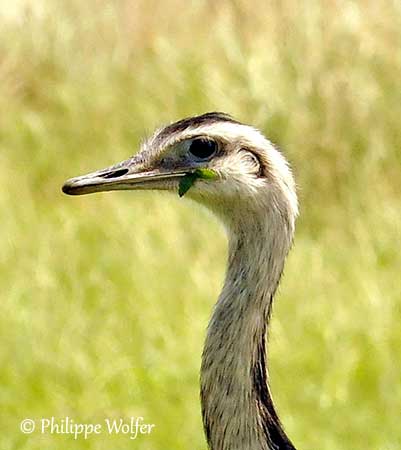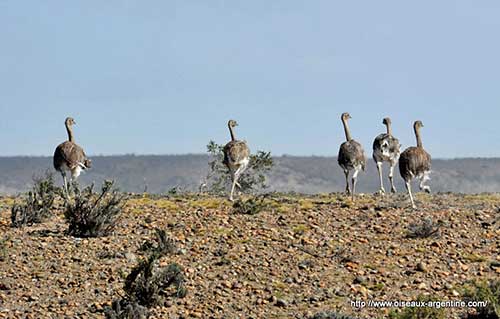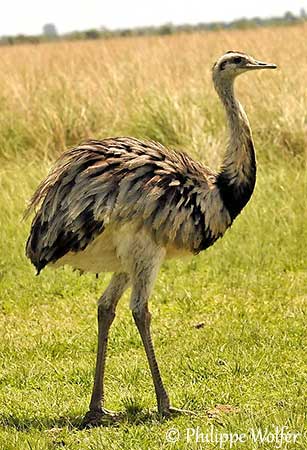
Photographers:
Philippe et Aline Wolfer
GALERIE
Text by Nicole Bouglouan
Sources:
HANDBOOK OF THE BIRDS OF THE WORLD vol 1 by Josep del Hoyo-Andrew Elliot-Jordi Sargatal - Lynx Edicions - ISBN: 8487334105
Animal Diversity Web (University of Michigan Museum of Zoology)
The Cornell Lab of Ornithology - Birds of the World
Rhea Birds… Care, Diet, History, and LOTS of Information
Wikipedia, the free encyclopaedia
LIST OF THE CARDS :
Greater Rhea - Rhea americana - Nandou d’Amérique
Lesser Rhea - Rhea pennata - Nandou de Darwin
List of the cards
at the bottom
FAMILY RHEIDAE
RHEIFORMES ORDER
Rheas
The family Rheidae contains only two species, the Greater Rhea and the Lesser Rhea, both are native to South America.
The Greater Rhea occurs in S and E South America, in Argentina, Bolivia, Brazil, Paraguay and Uruguay. It typically frequents low grasslands and pampas of South America, and habitats close to water. It breeds in more wet habitats.
But there is a population in N Germany. One male and five females escaped from a farm in 2000, and live now in the wild. They form a large group of about 500 individuals.

The Lesser Rhea is found from S Peru, SW Bolivia, Argentina and Chile, and the nominate race was introduced in Tierra del Fuego. It lives in the open plains of South America, usually in open land. All subspecies frequent grasslands, brushland and marshlands.
Both can be seen at high elevation. They feed primarily on plant matter including roots, seeds, leaves and fruits from a large variety of plants, including thistles. Insects and small vertebrates are also taken. They also ingest pebbles.
They forage by walking with mixed species such as deers, vicunas, alpacas, and sometimes cattle and sheep.
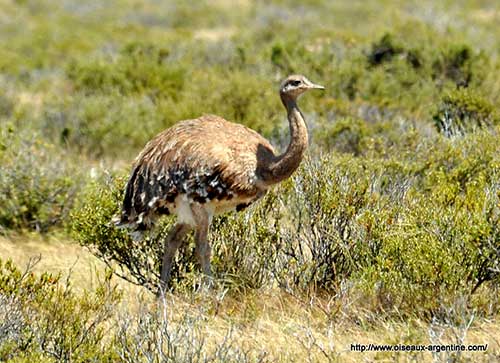
Rheas are large, flightless birds, well adapted to a terrestrial lifestyle. Their long legs allow them to run quickly and their large wings give them great manoeuvrability and help them to keep balance while running. They can reach a speed of 60 km/h. The powerful feet have only three toes. The neck is long but the head is fairly small.
The plumage is soft and smooth, usually grey and brown with white feather tips. Head and neck are feathered, as well the thighs and the upper part of the tarsi. There is a strong claw on each wing, often used as weapon.
Male and female are similar, but the male is slightly larger and darker. The juveniles are generally darker than adults.
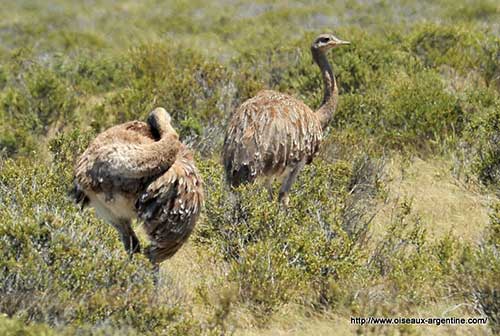
The sounds given by the rheas are deep and resounding, resembling the roar of a large mammal. These sounds described as “bu-up” and “nan-du” are produced by the male during the courtship displays, and occasionally at night too. They can be heard at a distance.
Other sounds like hoarse alarm calls snorts and hisses during aggressive behaviour, are heard outside the breeding season.
Greater Rhea : SOUNDS BY XENO-CANTO
Lesser Rhea : SOUNDS BY XENO-CANTO
Rheas are gregarious and often live in flocks of 5-30 individuals. But during the breeding season, the females leave the groups while the males become territorial. The males fight to establish their territories, until the winner chases away the other males before to attract several females into the territory.
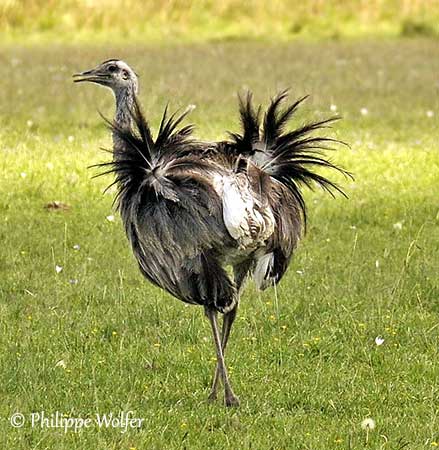
The male runs in zigzag pattern and uses both wings and neck to steer in different directions. It runs around the group of females while giving the typical “boom” sound. The neck is erect and inflated and the wings are raised.
At the end of the displays, the male stands beside the females. The neck is lowered in a U-shape while neck and head feathers are bristled up. It also shakes its wings before stretching them out to the sides, while the feather tips quiver softly in the wind.
Following the copulation, the male leads the group of females to the prepared nest where they lay their eggs one after another. They return to the nest 2-3 days later to lay more eggs. Then, they leave to mate with another male and lay their eggs in another nest. The male performs alone all the nesting duties.
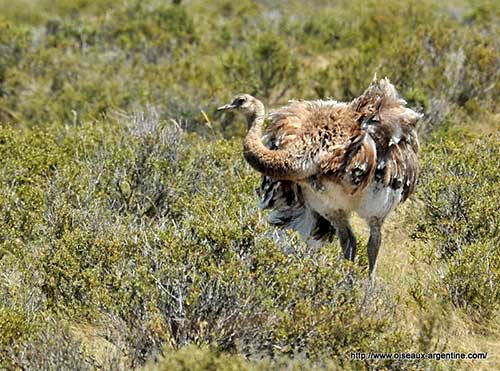
The nest-site is selected by the male and then, it also builds the nest, a shallow scrape in the ground with a lining of grass, leaves and twigs. It is built in a hidden location.
The different females lay their eggs, usually 10-30 eggs per nest, sometimes more. They are yellowish/olive green but they usually fade to buff.
The male incubates alone during about 40 days. The eggs hatch within 36 hours of each other. The male sometimes leaves the nest during the warmest hours of the day.
After hatching, the chicks grow quickly and reach the full size in about six months. The male protects them during this time. They can breed at two years.
The parental care may last up to six months, but the young rheas remain within the group until they can breed at 2-3 years old. Puma concolor and Panthera onca (cougar and jaguar) are among the usual predators of these birds.
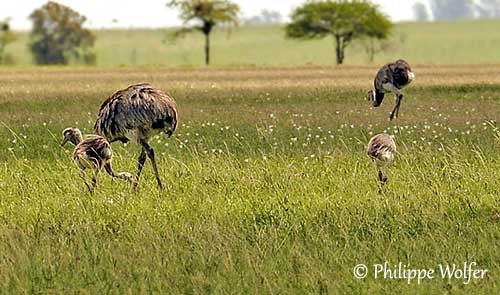
The rheas are hunted for their feathers, meat, eggs and other body parts. The habitat is destroyed by agriculture expansion.
The Greater Rhea is currently classified as Near Threatened.
The Lesser Rhea of nominate race is evaluated as Least Concern, but the two subspecies R. tarapacensis and R. garleppi are suspected to be declining due to habitat loss, hunting and egg collecting. They are currently listed as Near Threatened, although exact size and population trend are unknown, and they may be reclassified in the future.
